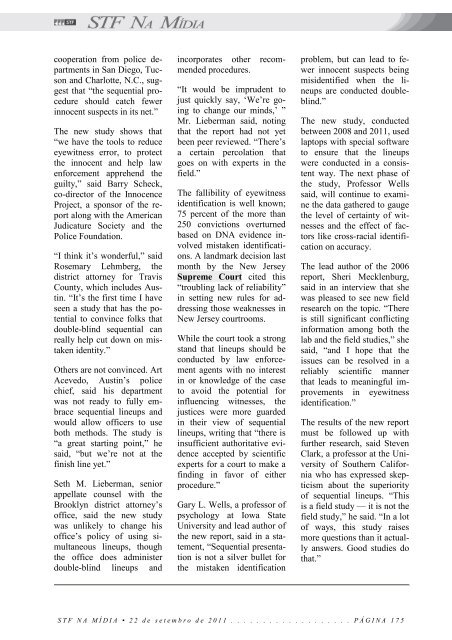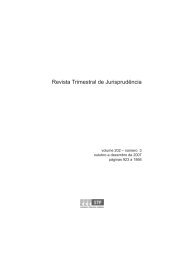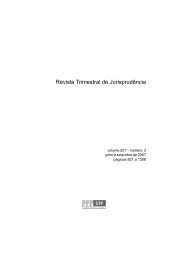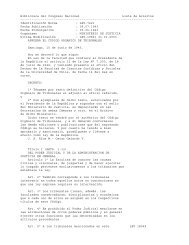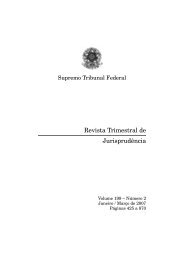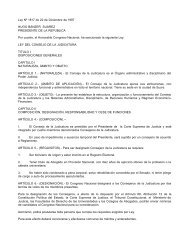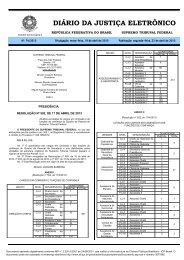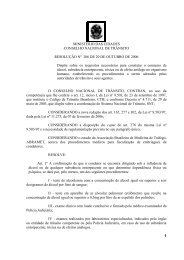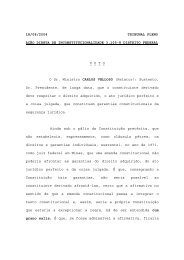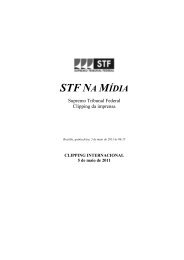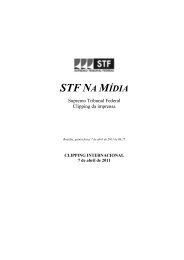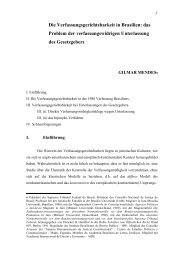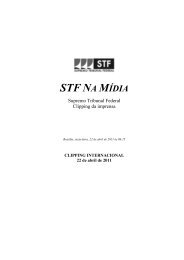STF NA MÍDIA
STF NA MÍDIA
STF NA MÍDIA
You also want an ePaper? Increase the reach of your titles
YUMPU automatically turns print PDFs into web optimized ePapers that Google loves.
cooperation from police departments<br />
in San Diego, Tucson<br />
and Charlotte, N.C., suggest<br />
that “the sequential procedure<br />
should catch fewer<br />
innocent suspects in its net.”<br />
The new study shows that<br />
“we have the tools to reduce<br />
eyewitness error, to protect<br />
the innocent and help law<br />
enforcement apprehend the<br />
guilty,” said Barry Scheck,<br />
co-director of the Innocence<br />
Project, a sponsor of the report<br />
along with the American<br />
Judicature Society and the<br />
Police Foundation.<br />
“I think it’s wonderful,” said<br />
Rosemary Lehmberg, the<br />
district attorney for Travis<br />
County, which includes Austin.<br />
“It’s the first time I have<br />
seen a study that has the potential<br />
to convince folks that<br />
double-blind sequential can<br />
really help cut down on mistaken<br />
identity.”<br />
Others are not convinced. Art<br />
Acevedo, Austin’s police<br />
chief, said his department<br />
was not ready to fully embrace<br />
sequential lineups and<br />
would allow officers to use<br />
both methods. The study is<br />
“a great starting point,” he<br />
said, “but we’re not at the<br />
finish line yet.”<br />
Seth M. Lieberman, senior<br />
appellate counsel with the<br />
Brooklyn district attorney’s<br />
office, said the new study<br />
was unlikely to change his<br />
office’s policy of using simultaneous<br />
lineups, though<br />
the office does administer<br />
double-blind lineups and<br />
incorporates other recommended<br />
procedures.<br />
“It would be imprudent to<br />
just quickly say, ‘We’re going<br />
to change our minds,’ ”<br />
Mr. Lieberman said, noting<br />
that the report had not yet<br />
been peer reviewed. “There’s<br />
a certain percolation that<br />
goes on with experts in the<br />
field.”<br />
The fallibility of eyewitness<br />
identification is well known;<br />
75 percent of the more than<br />
250 convictions overturned<br />
based on D<strong>NA</strong> evidence involved<br />
mistaken identifications.<br />
A landmark decision last<br />
month by the New Jersey<br />
Supreme Court cited this<br />
“troubling lack of reliability”<br />
in setting new rules for addressing<br />
those weaknesses in<br />
New Jersey courtrooms.<br />
While the court took a strong<br />
stand that lineups should be<br />
conducted by law enforcement<br />
agents with no interest<br />
in or knowledge of the case<br />
to avoid the potential for<br />
influencing witnesses, the<br />
justices were more guarded<br />
in their view of sequential<br />
lineups, writing that “there is<br />
insufficient authoritative evidence<br />
accepted by scientific<br />
experts for a court to make a<br />
finding in favor of either<br />
procedure.”<br />
Gary L. Wells, a professor of<br />
psychology at Iowa State<br />
University and lead author of<br />
the new report, said in a statement,<br />
“Sequential presentation<br />
is not a silver bullet for<br />
the mistaken identification<br />
problem, but can lead to fewer<br />
innocent suspects being<br />
misidentified when the lineups<br />
are conducted doubleblind.”<br />
The new study, conducted<br />
between 2008 and 2011, used<br />
laptops with special software<br />
to ensure that the lineups<br />
were conducted in a consistent<br />
way. The next phase of<br />
the study, Professor Wells<br />
said, will continue to examine<br />
the data gathered to gauge<br />
the level of certainty of witnesses<br />
and the effect of factors<br />
like cross-racial identification<br />
on accuracy.<br />
The lead author of the 2006<br />
report, Sheri Mecklenburg,<br />
said in an interview that she<br />
was pleased to see new field<br />
research on the topic. “There<br />
is still significant conflicting<br />
information among both the<br />
lab and the field studies,” she<br />
said, “and I hope that the<br />
issues can be resolved in a<br />
reliably scientific manner<br />
that leads to meaningful improvements<br />
in eyewitness<br />
identification.”<br />
The results of the new report<br />
must be followed up with<br />
further research, said Steven<br />
Clark, a professor at the University<br />
of Southern California<br />
who has expressed skepticism<br />
about the superiority<br />
of sequential lineups. “This<br />
is a field study — it is not the<br />
field study,” he said. “In a lot<br />
of ways, this study raises<br />
more questions than it actually<br />
answers. Good studies do<br />
that.”<br />
S T F N A M Í D I A • 2 2 d e s e t e m b r o d e 2 0 1 1 . . . . . . . . . . . . . . . . . . . P Á G I N A 1 7 5


